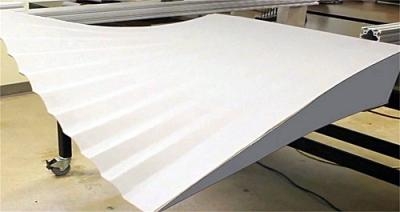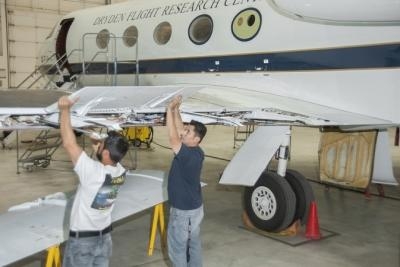Mon, Mar 03, 2014
Experimental Flaps Tested On NASA's Gulfstream G-III
A milestone for the Adaptive Compliant Trailing Edge (ACTE) project at NASA's Dryden Flight Research Center occurred in mid-February with the delivery of two revolutionary experimental flaps designed and built by FlexSys of Ann Arbor, MI, for installation on Dryden’s Gulfstream G-III Aerodynamics Research Test Bed aircraft.

Researchers are preparing to replace the airplane’s conventional 19-foot-long aluminum flaps with advanced, shape-changing assemblies that form continuous bendable surfaces. The new flexible flaps arrived at Dryden by truck on Feb. 12 and were immediately unpacked in preparation for ground vibration testing in NASA Dryden's Flight Loads Laboratory, followed by fit checks and eventual installation.
Technicians have begun scanning the G-III with a special laser system to create a computer-generated 3-D model of the airplane. The flap assemblies will also be scanned so that project engineers can conduct virtual fit checks before actually installing the new flaps. This will reduce the risk of damaging either the airplane or its new control surfaces.
The ACTE experimental flight research project is a joint effort between NASA and the U.S. Air Force Research Laboratory to advance compliant structure technology for use in aircraft to significantly reduce drag, wing weight, and aircraft noise. The effort is part of NASA's Environmentally Responsible Aviation (ERA) project that explores and documents the feasibility, benefits and technical risk of vehicle concepts and enabling technologies to reduce aviation’s impact on the environment.
(Top image: A flexible fluted structure that bridges the gap between the wing root and the shape-changing wing flap that will undergo flight tests on NASA's G-III Aerodynamic Research Test Bed is shown during preliminary tests at FlexSys, Inc. (FlexSys Photo), Bottom NASA aircraft technicians Leo and Juan Salazar work on installation of test instrumentation in preparation for installation of the experimental Adaptive Compliant Trailing Edge flap on NASA's modified G-III Aerodynamic Research Test Bed aircraft.)

More News
Klyde Wonders If The 'New' SouthWest Can 'Out-Spirit' Spirit... FMI: www.klydemorris.com>[...]
From 2012 (YouTube Edition): Extensive Expertise in Backup Solutions Makes MCIA Uniquely Qualified In This Market There's no such thing, in aviation, as TOO much caution... hence t>[...]
Aero Linx: Historic Aircraft Association (HAA) The Historic Aircraft Association (HAA) was founded in 1979 with the aim of furthering the safe flying of historic aircraft in the UK>[...]
Jamming Denotes emissions that do not mimic Global Navigation Satellite System (GNSS) signals (e.g., GPS and WAAS), but rather interfere with the civil receiver's ability to acquir>[...]
"Respectfully, U.S. and European airlines should not be even contemplating the future purchase of airplanes from Chinese military companies...” Source: US Representative Raja>[...]
 Klyde Morris (05.02.25)
Klyde Morris (05.02.25) Classic Aero-TV: Introducing The MD302--Mid-Continent's Standby Attitude Module
Classic Aero-TV: Introducing The MD302--Mid-Continent's Standby Attitude Module ANN's Daily Aero-Linx (05.04.25)
ANN's Daily Aero-Linx (05.04.25) ANN's Daily Aero-Term (05.04.25): Jamming
ANN's Daily Aero-Term (05.04.25): Jamming Aero-News: Quote of the Day (05.04.25)
Aero-News: Quote of the Day (05.04.25)




